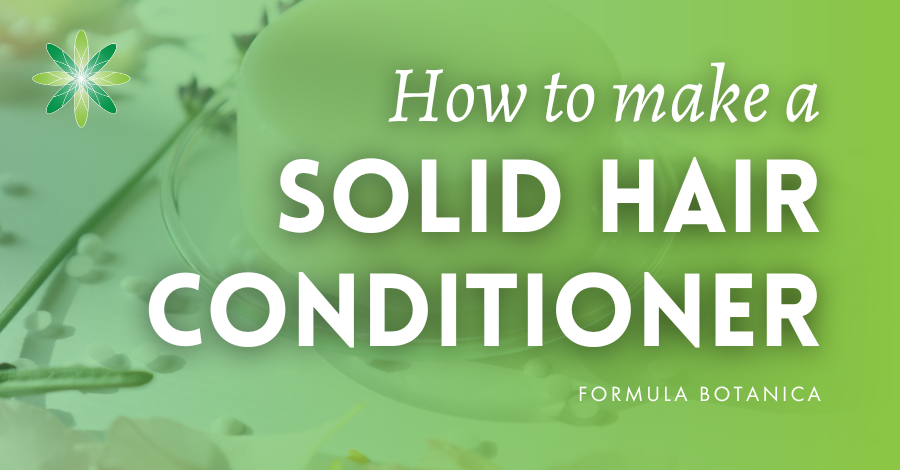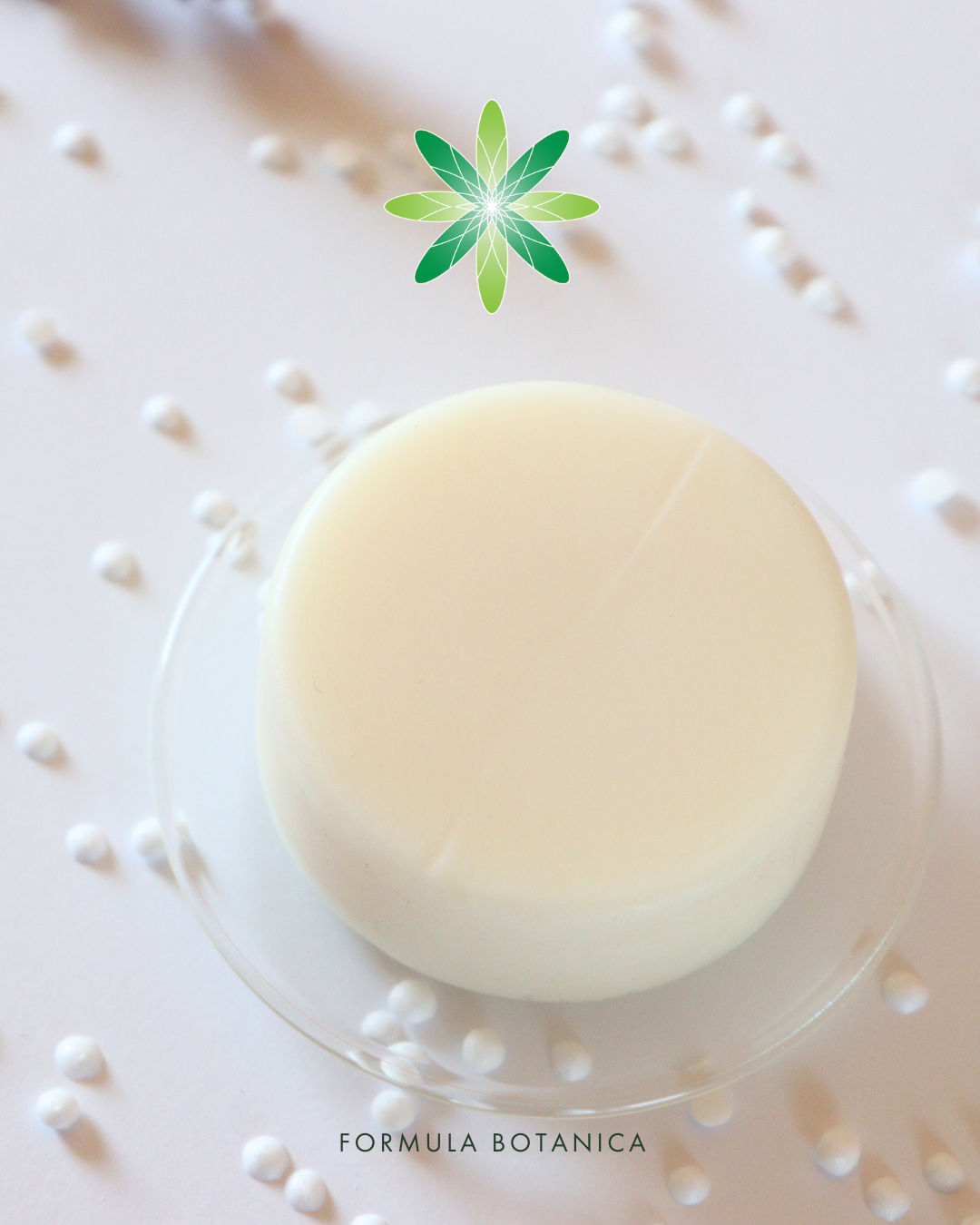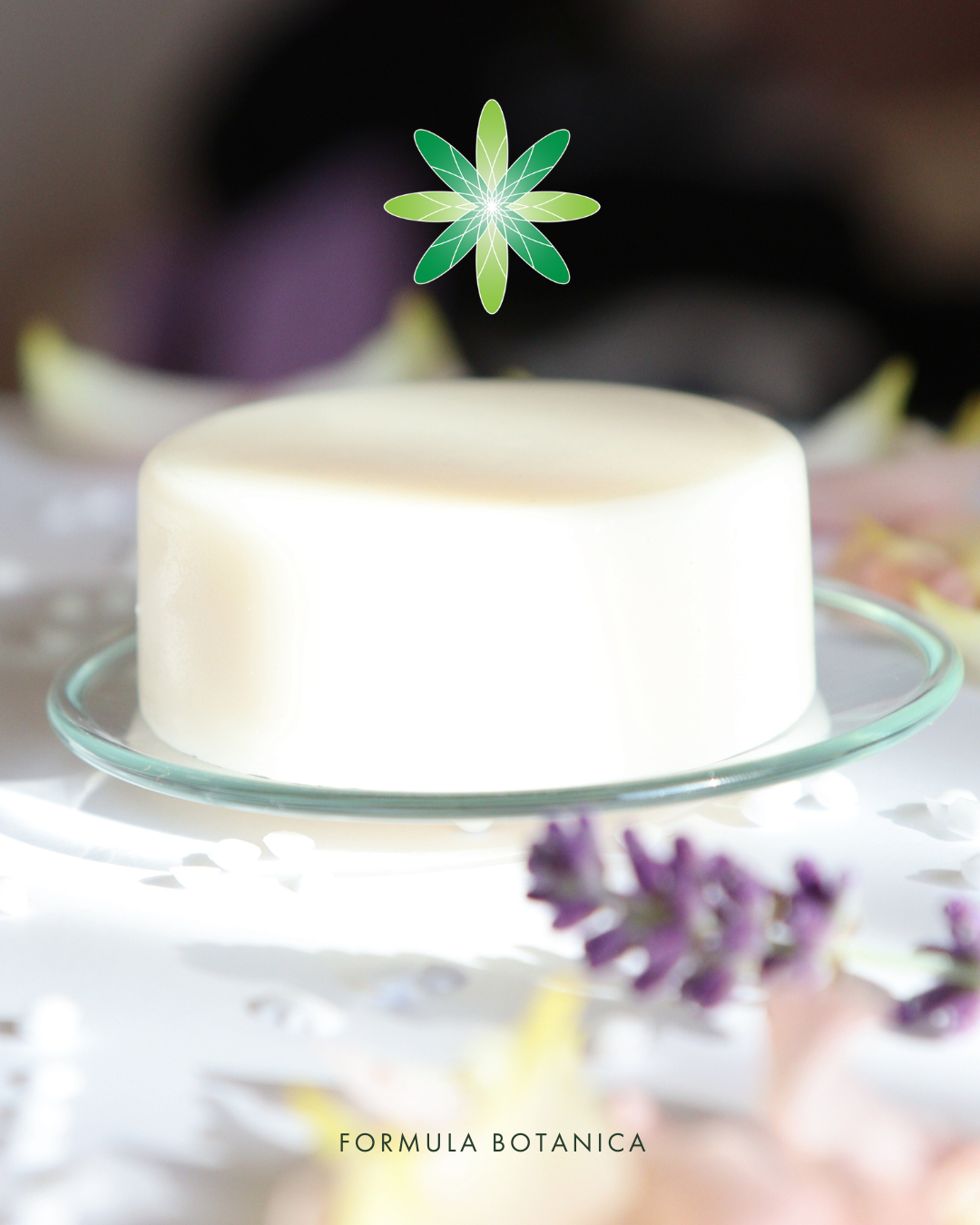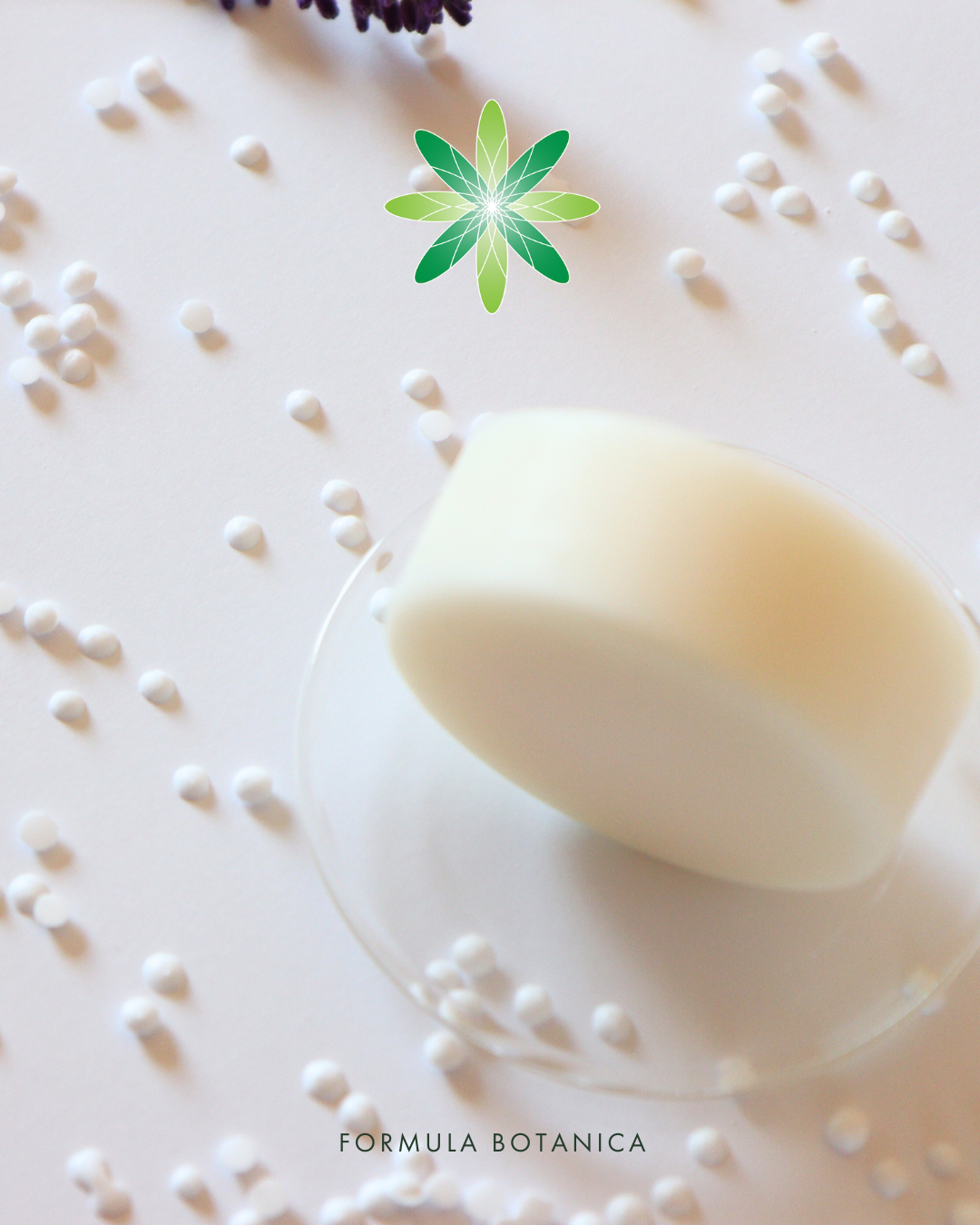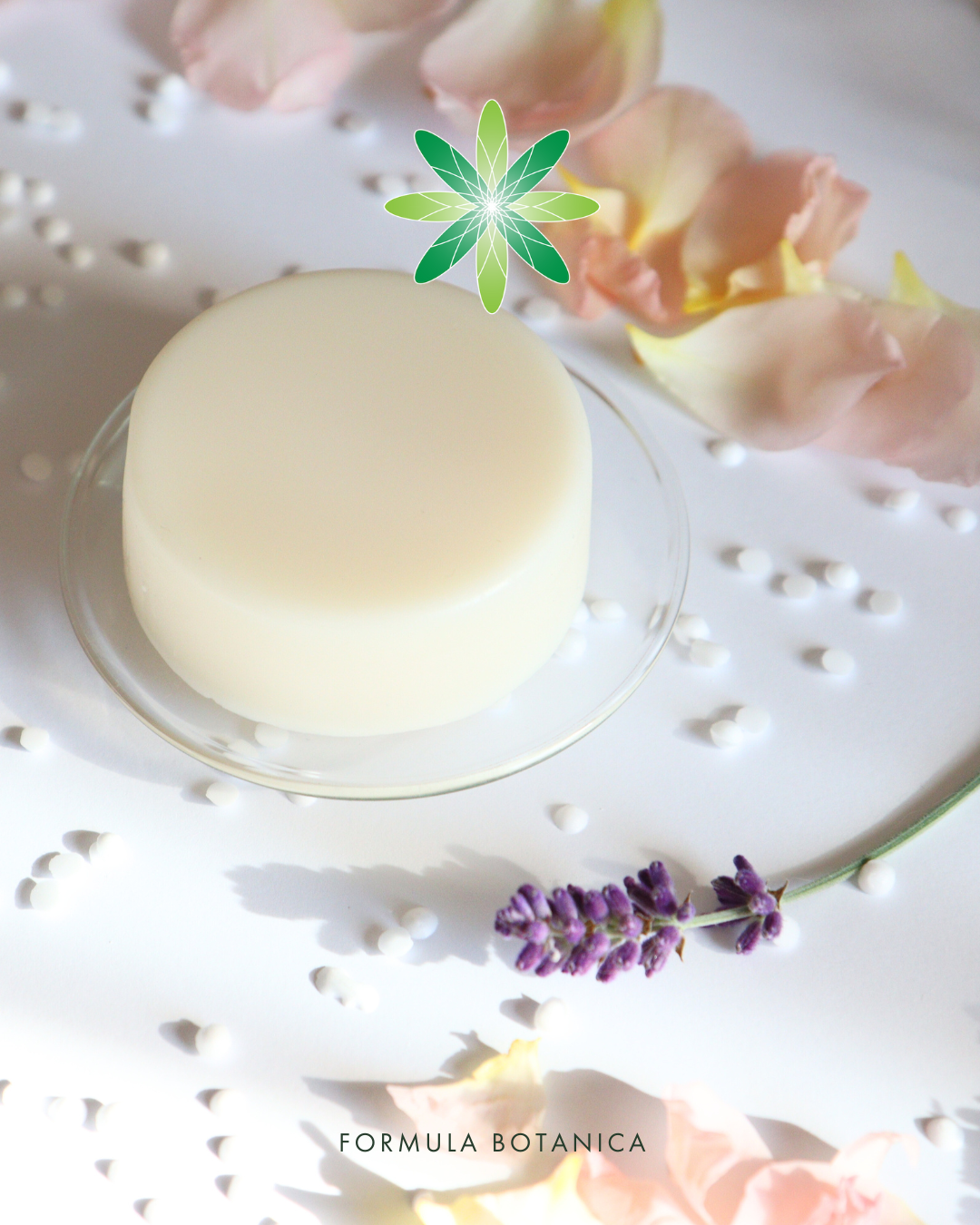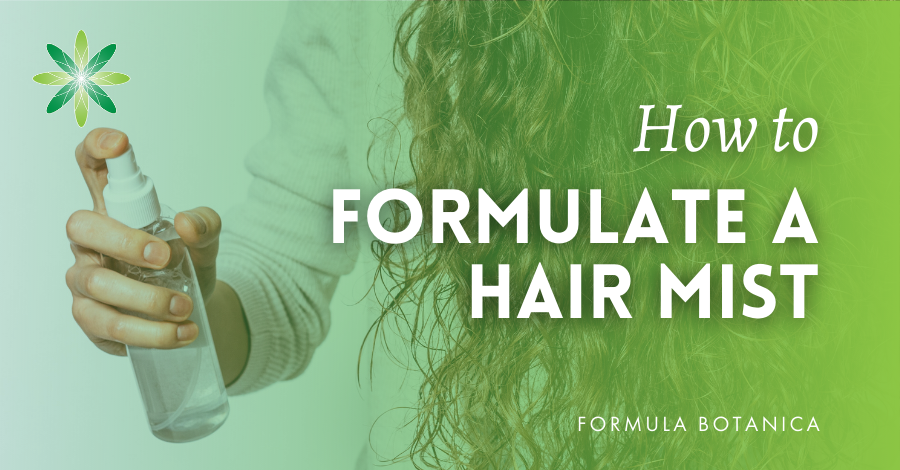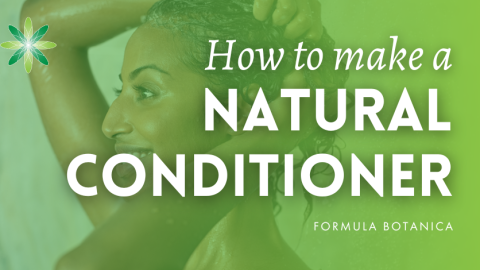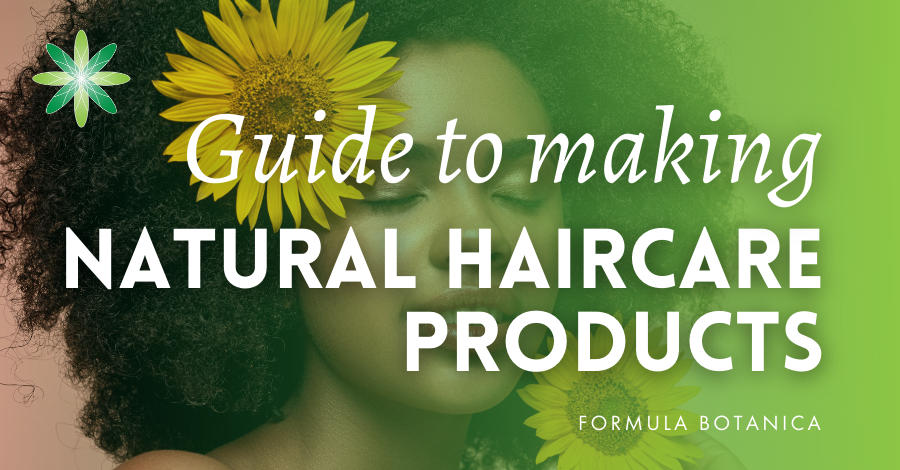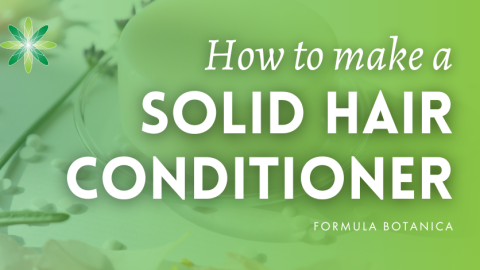Updated: 25.02.25
I still remember the day I created my very first solid formulation. It was such a fun and rewarding experience to watch it all come together, from blending and melting the oils to letting the bar set and take shape. So you can imagine how excited I am to show you how to make a solid hair conditioner bar in today’s post!
This conditioner bar has rich conditioning and moisturising properties that coat the hair shafts and moisturise the scalp. It’s also the perfect follow-up to your shampoo or shampoo bar and makes for a great, thoughtful gift. Plus, with the growing demand for solid beauty and zero-waste, this conditioner is right on trend!
If you’re new to formulation, this is the perfect place to start. This solid hair conditioner bar is super easy and satisfying to make and takes only six steps. And I guarantee you’ll feel super accomplished once you hold the finished bar in your hands!
What is a hair conditioner?
A hair conditioner is a rinse-off product you use after shampooing to nourish and condition your hair – leaving it soft, shiny, and more manageable.
When formulating hair conditioners, it’s essential to use an emulsifier with a cationic charge to get the best results, which is what I’ve done with this conditioner. That’s because the hair shaft naturally carries a negative charge, so the positively charged emulsifier (cationic) forms a strong bond with the hair fibres, allowing it to work its conditioning magic.
Also, unlike the surfactants used in skin-cleansing products (which can be ionic or non-ionic), cationic surfactants don’t rinse off as easily with water. This makes them ideal for haircare, as they form a thin, continuous protective layer over the hair. This protective layer helps lock in moisture, while adding softness, strength, and shine to your hair. Pretty powerful stuff, right?
Don’t worry if you can’t understand all these terms now. You’ll get more knowledgeable as your formulation journey progresses. You can learn all about haircare science and how to formulate effective natural and organic haircare in our Diploma in Organic Haircare Formulation.
What are solid cosmetics?
In this post, I’m showing you how to make a solid conditioner, but let’s first take a moment to define what solid cosmetics are.
Solid cosmetics are concentrated products that come with a range of benefits. They’re lightweight and don’t typically require any packaging, which significantly reduces transportation costs and the environmental impact of distribution.
They also tend to have longer shelf lives, a smaller carbon footprint, and produce less waste, making them a more sustainable choice compared to your traditional beauty products.
Myths & misconceptions
Many people assume that solid products can’t perform as well as their liquid counterparts. However, when properly formulated, solid cosmetics can deliver equal – and sometimes superior – results. But don’t just take my word for it! Listen to this podcast episode to find out more about solid cosmetics:
Another common misconception is that solid cosmetics are “waterless.” While many solid products are anhydrous (oil-based), the term “waterless” is misleading. After all, every cosmetic product carries a water footprint through its production, distribution, and use. Check out these resources to uncover more about “waterless” beauty:
Podcast 83: How waterless beauty greenwashed the beauty world
If you’re curious to learn more about solid formulations, you can also refer to our Solid Cleanser Mini Lab, available exclusively on our membership site, the Lab at Formula Botanica.
How to use this natural hair conditioner
Now that we’ve covered what conditioners and solid cosmetics are, let’s talk about the star of this post: the solid conditioner. Using it couldn’t be easier.
Start by wetting the bar and rubbing it between your hands until it forms a creamy, milky layer as the ingredients emulsify with water. Next, glide the bar gently over your damp hair, focusing on the mid-lengths and ends where extra conditioning is often needed. Let the nourishing ingredients work their magic for a few minutes before rinsing thoroughly. Easy, right?
Key ingredients
For this conditioner, I’ve selected a few botanical ingredients that are not only effective but also easy to source. Let’s break them down:
Emulsifier
Aminosensyl™ HC takes centre stage as the cationic emulsifier in this formulation. Specifically designed for haircare, it’s ideal for solid bars, anhydrous treatments, and traditional cream conditioners.
Botanical oils
For this conditioner bar, I’ve selected two of my favourite botanical oils: jojoba and squalane.
Jojoba is renowned for its exceptional moisturising and conditioning properties for both hair and scalp. It’s technically a liquid wax and it’s exceptionally stable and resistant to heat and oxidation. Curious to learn more about jojoba’s properties? Check out this post:
Squalane is a light, non-greasy emollient that acts as an excellent natural alternative to silicone. It provides a beautiful, radiant shine to the hair without any added weight. You can find out more about squalane below:
Both squalane and jojoba work great in this formulation, as they don’t leave the hair feeling greasy or heavy.
If you’re interested in learning more about silicones and their natural alternatives, you can explore this topic further in the Silicone Alternatives Mini Lab as part of your membership at the Lab at Formula Botanica.
Extracts and essential oils
To complete this formula, I’ve added rosemary extract along with clary sage and lavender essential oils. These give the conditioner its gorgeous scent.
Rosemary CO2 extract is also a great antioxidant and helps extend the shelf life of your bar as well as bringing added haircare benefits. Want to learn more about rosemary? Check out the posts below:
Our formulation: Solid hair conditioner bar
Makes: 100g
Time: 30 minutes (Excluding setting time)
Level: Beginner-friendly
| Phase | Ingredients | INCI | Weight (g) |
| A | Aminosensyl™ HC | Brassica Alcohol (and) Brassicyl Valinate Esylate | 73.00 |
| A | Cetyl alcohol | Cetyl Alcohol | 13.00 |
| A | Jojoba oil | Simmondsia Chinensis Seed Oil | 8.00 |
| A | Squalane | Squalane | 3.50 |
| B | Spectrastrat™ Natural G2 MB* | Caprylhydroxamic Acid (and) Glyceryl Caprylate (and) Glycerin | 1.50 |
| C | Rosemary CO2 extract | Rosmarinus Officinalis Leaf Extract | 0.20 |
| C | Clary sage essential oil | Salvia Sclarea Leaf Oil | 0.40 |
| C | Lavender essential oil | Lavandula Angustifolia Flower Oil | 0.40 |
| Total: 100.00 |
*Note: A preservative has been added to this formula because, while solid products generally have good microbial stability, this conditioner bar will come into contact with water during use. The addition of a preservative safeguards the product against potential contamination from bacteria, yeast, and mould, ensuring it remains safe and effective.
If you’re interested in learning more about natural preservation, check out our Diploma in Organic Skincare Formulation for in-depth insights.
Equipment:
- Scales
- Glass beakers
- Hot plate
- Water bath
- Glass rods/Spatulas
- Mini whisk
- Pipettes
Formulation method
To create this solid hair conditioner bar, you’ll need to follow these steps:
Step 1: Prepare your workspace
Start by setting up a clean and organised workspace. Sanitise your utensils and workspace and ensure you’re wearing appropriate PPE – as per GMP – which we cover in-depth in our Diploma in Organic Skincare Formulation.
Step 2: Weigh your ingredients
Carefully weigh each of your ingredients. After each addition, press the “tare” button on your scale to zero it out. Weigh your ingredients into separate beakers based on their respective phases: A, B, and C.
Step 3: Melt the oils and emulsifier
Place the jojoba oil, squalane, Aminosensyl™ HC, and cetyl alcohol into a heat-proof container. Gently melt these ingredients in a water bath, heating to 75-80°C until fully dissolved and combined.
Step 4: Add the rosemary extract and essential oils
Once your blend is melted, let it cool slightly while stirring gently with a glass rod. When the temperature reaches 60-65°C, add the rosemary extract and essential oils. Stir again until fully combined. Measure the pH and adjust if necessary. Then add the preservative, stir it in, and measure the pH again.
Note: Since this is a hot-fill product, you’ll need to add your heat-sensitive ingredients at 60-65°C to minimise heat exposure and preserve their properties, rather than waiting for the blend to cool below 40°C.
Step 5: Pour the blend and let it set
Immediately pour the blend into your chosen mould. Allow it to cool and harden fully before removing it from the mould.
Step 6: Wrap and label
Once the bar has cooled and set, carefully remove it from the mould. Wrap it securely and label it with the product name, batch number, and production date. Store in a cool, dry place away from direct light and heat.
And that’s it! I hope you enjoy your handmade solid conditioning bar!
Formulation notes:
- Aminosensyl™ HC is a 100% natural quat-free hair-conditioning ingredient that is easily biodegradable. It is safe and gentle for humans and non-toxic to aquatic life. It provides deep conditioning properties to the hair and is ideal for haircare products like conditioners, hair masks, or intense hair repair treatments.
- Cetyl alcohol is a non-ionic, coconut-and palm-derived co-emulsifier and thickener.
- Jojoba oil is an effective moisturiser that nourishes the skin and hair without being heavy or greasy.
- Squalane is a lightweight emollient with silicone-like properties.
- Spectrastat™ G2 Natural MB is a natural preservative that’s effective against bacteria, yeasts and mould over a broad pH range. It is compatible with cationic ingredients.
- Rosemary CO2 extract is a potent antioxidant and antimicrobial extract that prevents the oxidation of oils and essential oils in the formula.
- The essential oils offer a calming and uplifting effect and provide the conditioner bar with a pleasant and refreshing scent.
Suggested suppliers
Many of the suppliers below ship internationally. I’ve indicated their country or regional base for your convenience.
Aroma-Zone (EU)
Aromantic (UK)
Alexmo Cosmetics (EU)
Manske (EU)
The Soap Kitchen (UK)
Ellemental (EU)
Lotioncrafter (USA)
Essential Labs (USA)
Go Native NZ (New Zealand)
Naturally Balmy (UK)
O&3 – The Oil Family (UK/EU)
Soap & More (Canada)
Handymade (EU)
FAQ
- What is a solid hair conditioner?
As its name indicates, a solid hair conditioner is a product you typically use after shampooing to nourish and condition your hair.
- How do you use a solid conditioner?
To use a solid conditioner, simply wet the bar and rub it between your hands. This will create a light foam foam. Next, glide the bar over your hair, wait a few minutes like for a regular conditioner, and rinse it out – just like a traditional conditioner.
- Are solid conditioners waterless?
This is a myth. While solid conditioners don’t contain water in them, they require water for their production, distribution, and more. However, they do have a lower carbon footprint and produce less waste than traditional conditioners, as they require less space and often need no packaging. They also last longer than traditional liquid products.
- Can you customise this solid conditioner?
Absolutely! This conditioner is fully customisable. You can add active ingredients like hydrolysed proteins for extra nourishment or swap out the emollients, oil-soluble extracts, or essential oils to suit your unique hair needs or preferences.
Learn how to formulate your own organic skincare
I hope you enjoyed making this conditioner bar! If you did, let me know in the comments below – I’d love to hear your thoughts.
If you’d like to make more solid formulations, we have plenty available on our blog – all for free. Here are some of my personal favourites:
Solid formulations: How to make a solid cleansing bar
How to make a cocoa shampoo bar
Formulate a green tea and cocoa body balm stick
How to formulate a natural deodorant stick
How to make a facial cleansing stick
6 solid beauty bars perfect for beginners to make at home
Why a balm stick should be the next skincare product you formulate
If you’re ready to move beyond following recipes and want to create your own formulas, sign up for our free Botanical Formulation Course and become an organic formulator instead of a recipe follower.
FREE TRAINING
Learn how to become an
Organic Skincare Formulator
FREE TRAINING
How to become an
Organic Skincare Entrepreneur
FREE TRAINING
How to become an
Organic Skincare Entrepreneur
Leave us a comment

Miroslava is a former grading tutor at Formula Botanica. She has a Ph.D in neuroscience, expertise in biology and chemistry, and a lifelong passion for natural cosmetic formulation.

